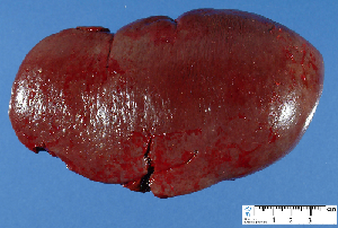
Description
The spleen, in healthy adult humans, is approximately 11 centimetres (4.3 in) in length. It usually weighs between 150 grams (5.3 oz) and 200 grams (7.1 oz).
The spleen is 1" by 3" by 5", weighs approximately 7 oz, and lies between the 9th and 11th ribs on the left hand side.
Function
Colour
Dark red.
Shape
An elongated sponge like tissue organ similar to a medium water balloon.
Location
In the upper left quadrant of the abdomen.
The spleen, in healthy adult humans, is approximately 11 centimetres (4.3 in) in length. It usually weighs between 150 grams (5.3 oz) and 200 grams (7.1 oz).
The spleen is 1" by 3" by 5", weighs approximately 7 oz, and lies between the 9th and 11th ribs on the left hand side.
Function
- Mechanical filtration of red blood cells. In mice: Reserve of monocytes.
- Production of opsonins, properdin, and tuftsin.
- Creation of red blood cells. While the bone marrow is the primary site of hematopoiesis in the adult, the spleen has important hematopoietic functions up until the fifth month of gestation. After birth, erythropoietic functions cease, except in some hematologic disorders. As a major lymphoid organ and a central player in the reticuloendothelial system, the spleen retains the ability to produce lymphocytes and, as such, remains an hematopoietic organ.
- Storage of red blood cells, lymphocytes and other formed elements. In horses, roughly 30% of the red blood cells are stored there. The red blood cells can be released when needed. In humans, up to a cup (236.5 ml) of red blood cells can be held in the spleen and released in cases of hypovolemia. It can store platelets in case of an emergency. Up to a quarter of lymphocytes can be stored in the spleen at any one time.
Colour
Dark red.
Shape
An elongated sponge like tissue organ similar to a medium water balloon.
Location
In the upper left quadrant of the abdomen.
 RSS Feed
RSS Feed
